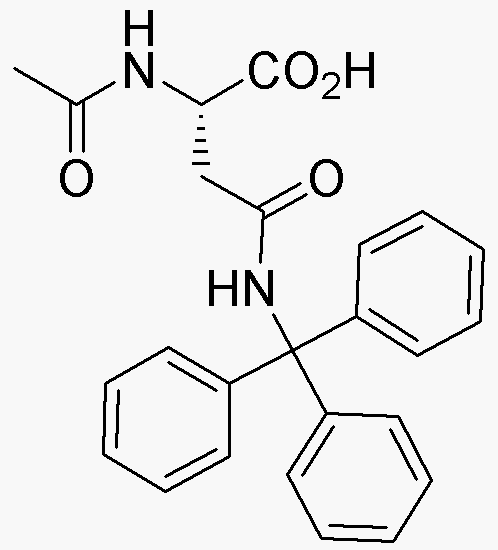Na-Acetyl-Ng-trityl-L-asparagine is widely utilized in research focused on:
- Peptide Synthesis: This compound serves as a key building block in the synthesis of peptides, allowing researchers to create specific sequences for studying protein interactions and functions.
- Drug Development: It plays a role in the formulation of pharmaceuticals, particularly in designing drugs that target specific biological pathways, enhancing efficacy and reducing side effects.
- Biotechnology: In biotechnological applications, it is used to modify proteins, improving their stability and activity, which is crucial for developing biocatalysts and therapeutic proteins.
- Analytical Chemistry: This compound is utilized in various analytical techniques, such as chromatography, to separate and identify complex mixtures, aiding in quality control and research.
- Research in Neurobiology: It is involved in studies related to neurotransmitter functions, providing insights into neurological disorders and potential treatment strategies.
General Information
Properties
Safety and Regulations
Applications
Na-Acetyl-Ng-trityl-L-asparagine is widely utilized in research focused on:
- Peptide Synthesis: This compound serves as a key building block in the synthesis of peptides, allowing researchers to create specific sequences for studying protein interactions and functions.
- Drug Development: It plays a role in the formulation of pharmaceuticals, particularly in designing drugs that target specific biological pathways, enhancing efficacy and reducing side effects.
- Biotechnology: In biotechnological applications, it is used to modify proteins, improving their stability and activity, which is crucial for developing biocatalysts and therapeutic proteins.
- Analytical Chemistry: This compound is utilized in various analytical techniques, such as chromatography, to separate and identify complex mixtures, aiding in quality control and research.
- Research in Neurobiology: It is involved in studies related to neurotransmitter functions, providing insights into neurological disorders and potential treatment strategies.
Documents
Safety Data Sheets (SDS)
The SDS provides comprehensive safety information on handling, storage, and disposal of the product.
Product Specification (PS)
The PS provides a comprehensive breakdown of the product’s properties, including chemical composition, physical state, purity, and storage requirements. It also details acceptable quality ranges and the product's intended applications.
Certificates of Analysis (COA)
Search for Certificates of Analysis (COA) by entering the products Lot Number. Lot and Batch Numbers can be found on a product’s label following the words ‘Lot’ or ‘Batch’.
Numéro de catalogue
Numéro de lot/série
Certificates Of Origin (COO)
This COO confirms the country where the product was manufactured, and also details the materials and components used in it and whether it is derived from natural, synthetic, or other specific sources. This certificate may be required for customs, trade, and regulatory compliance.
Numéro de catalogue
Numéro de lot/série
Safety Data Sheets (SDS)
The SDS provides comprehensive safety information on handling, storage, and disposal of the product.
DownloadProduct Specification (PS)
The PS provides a comprehensive breakdown of the product’s properties, including chemical composition, physical state, purity, and storage requirements. It also details acceptable quality ranges and the product's intended applications.
DownloadCertificates of Analysis (COA)
Search for Certificates of Analysis (COA) by entering the products Lot Number. Lot and Batch Numbers can be found on a product’s label following the words ‘Lot’ or ‘Batch’.
Numéro de catalogue
Numéro de lot/série
Certificates Of Origin (COO)
This COO confirms the country where the product was manufactured, and also details the materials and components used in it and whether it is derived from natural, synthetic, or other specific sources. This certificate may be required for customs, trade, and regulatory compliance.


